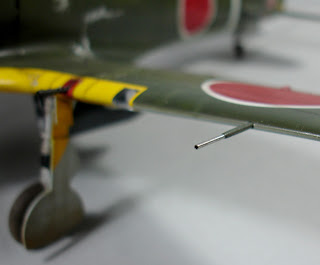Nice
film footage of the restored Dakota Blayde Zero A1-1-129. This aircraft, a Nakajima-built A6M2 s/n 1498, was restored from a wreck discovered in the Ballale Island jungles in the Solomons in 1965. The airplane's restoration has been praised by Japanese aeronautical engineers and other world experts. Everything is original on the aeroplane except the engine, a Pratt & Whitney R-1830. The restoration took several decades to complete. Note the colour and the presence of yellow IFF strips on wings and white-outline fuselage Hinomaru.
Hat tip to Ronnie.
Since blogging this
Ryan Toews has commented. His comment is so interesting and informative (and corrects the information above) that it deserved to be included with the blog post (I hope Ryan doesn't mind):-
"Please allow me to provide you with some background on the Zero in the linked YouTube video. In 1968 Bob Diemert of Carman, Manitoba, recovered several wrecked Japanese aircraft. The recovered pieces bore the serial numbers 6345, 5355, 4362, 5459, 3471, 7830, 2985 (Nakajima A6M2 21); 3285 (A6M3 32); 3753 (A6M3 22) - 3753. Of the tail codes only three are known: W1-106, W1-187 overpainted with 6-136, and 5-136 overpainted with 3-174. Diemert also mentioned that none of the recovered tails came from any of the fuselage sections that he took from Ballale Island. Diemert completed two Zeros from the wreckage he brought back to Canada. Frustratingly, he kept no records of what parts were used for each rebuilt aircraft.
His first Zero was sold to the USMC Museum in Virginia and is now part of the Naval Air Museum in Pensacola, Florida. The second Zero was built for the Confederate Air Force and has since been sold to the Pacific Aviation Museum in Hawaii. In the mid-90s Diemert sold all of his remaining Japanese material to John and Earl Calverley, the owners of Blayd Corporation, also located in Carman. The new Blayd Zero was constructed as a Nakajima built A6M2 by duplicating about 14,000 components using the original parts as templates. Thus the plane has only about 5% original parts. I was fortunate to become involved and was asked to come up with a paint scheme. Initially I hoped to duplicate the one of the Ballale wrecks but it proved impossible to establish any link between the known serial numbers and tail codes. Attention then turned to one of the few Nakajima A6M2s for which, at the time, both the tail code and serial number were known. This was A6M2, s/n 6544, tail code A1-1-129, downed over Russell Island on 4 February, 1943. This Zero was photographed by the Americans when they occupied Russell Island. Some artifacts which confirmed the serial number were also collected. The tail code identified this aircraft as being from the Zuikaku. The serial number 6544 also provided a date of manufacture in late December, 1942. Given the markings and date of the loss of A1-1-129 it must have been flown by one of the two Zuikaku pilots lost on February 4, 1943. Circumstantial evidence seems to suggest that the pilot was CPO Soji CHIBA.
The overall paint colour was based on existing artifacts in the Blayd collection and mixed using modern aircraft paint. The final colour was slightly lighter than FS 16350, which is very close to the paint colour Nick has arrived at in his research. The completed airframe the Zero was transported to Tri-State Aviation in Wahpeton, North Dakota for installation of the engine and instruments. As stated, the Zero had been given a serial number that bore no relationship to any of the Diemert/Blayd artifacts. However, for export purposes it was necessary to assign an “official” serial number to the plane. Therefore a sub-assembly plate with the serial number 1498 was used. This plate was not an actual A6M2 identification plate, but was in fact a manufacturer’s plate for an A6M2 flap (Part number 4611). Fortunately, customs showed no interest in the actual provenance of this serial number. The Zero was completed in Wahpeton and was kept initially at the Fargo Air Museum in Fargo, ND, after its purchase by several Minnesota and North Dakota warbird collectors. After the tragic death of Gerry Beck, the owner of Tri-State Aviation, the plane was moved to the Dakota Territory Air Museum in Minot, ND. It has recently again been resold to the Texas Flying Legends Museum in Houston. The YouTube video is from a DVD that was shot by a Japanese film crew in the autumn of 2010 in Minot ND. I was able to go out to see at least part of the video shoot. Unfortunately, while on the previous day the crew completed several hours of aerial photography, on the day I was out heavy thunderstorms prevented any flying time. This was particularly disappointing as I was assured that there was an extra seat available for me in the Beechcraft chase plane."
Thanks Ryan!
Image credits:-© http://www.web-wac.co.jp/




























